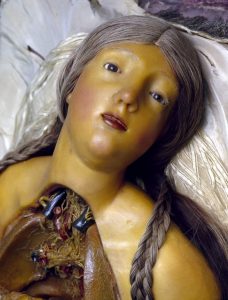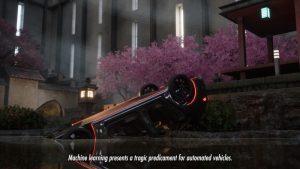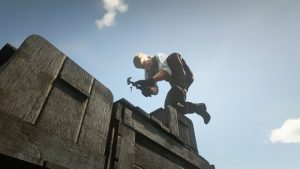Previously: Olivier – The French Foreign Legion.
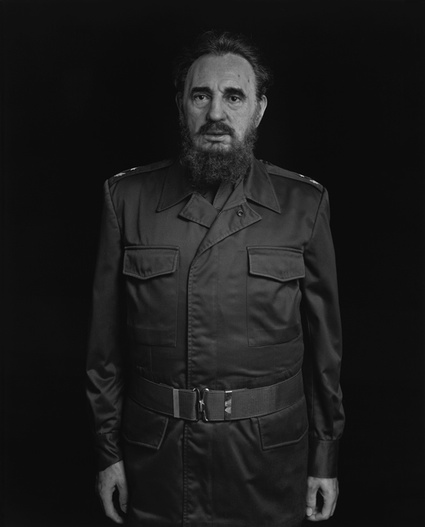 © Hiroshi Sugimoto, Fidel Castro, 1999
© Hiroshi Sugimoto, Fidel Castro, 1999
It was a masterful idea to open the exhibition Portraits and Power at CCC Strozzina in Florence with the dramatic and almost intimidating portrait of Fidel Castro by Hiroshi Sugimoto. The photography is deceitful though, the Cuban leader never stood in front of Sugimoto. His wax figure at the Madame Tussaud’s Museum did. The figures are illumined by a source of direct light and strongly stand out against a black background in an extremely theatrical way, imitating poses typical of the characters they represent, while removing them from all context and thus emphasizing their nature as icons rather than human beings. Interestingly, the resulting image appears “more real” than the wax statues.
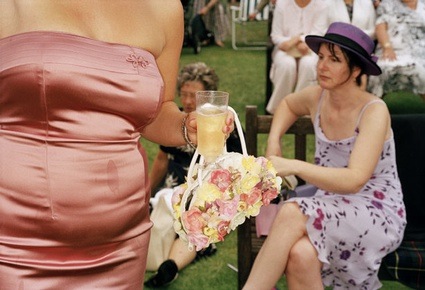 Martin Parr, Ascott, England, 2003. Luxury
Martin Parr, Ascott, England, 2003. Luxury
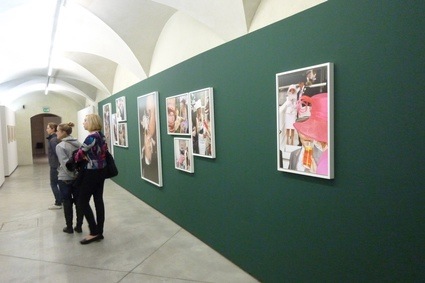 Portraits and Power explores portraiture and contemporary representation of political, economical and social power through the works of artists. Images nowadays have the role not only to represent but also to affirm power. Ask David Cameron. The UK Prime Minister has appointed his “personal photographer” Andrew Parsons to a civil service post responsible for recording the coalition in government. The controversial move ensures that, right from the start of the electoral campaign, the Prime Minister has been represented in the most opportune fashion (an approach that mister Putin is no doubt working on.) Before him already, Tony Blair had benefited from the ‘unofficial’ and ‘intimate’ photographs that Nick Danziger had shot of the PM everyday life on the occasion of his fiftieth birthday.
Portraits and Power explores portraiture and contemporary representation of political, economical and social power through the works of artists. Images nowadays have the role not only to represent but also to affirm power. Ask David Cameron. The UK Prime Minister has appointed his “personal photographer” Andrew Parsons to a civil service post responsible for recording the coalition in government. The controversial move ensures that, right from the start of the electoral campaign, the Prime Minister has been represented in the most opportune fashion (an approach that mister Putin is no doubt working on.) Before him already, Tony Blair had benefited from the ‘unofficial’ and ‘intimate’ photographs that Nick Danziger had shot of the PM everyday life on the occasion of his fiftieth birthday.
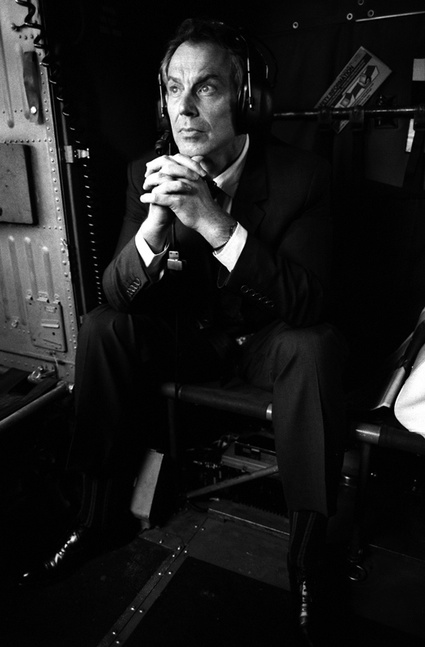 © Nick Danziger, Helicopter Flight from RAF Lyneham to Battersea, 3 April 2003
© Nick Danziger, Helicopter Flight from RAF Lyneham to Battersea, 3 April 2003
Portraits and Power not only dissects power as an expression of the charisma of those individuals who have become icons of their age. It also explores the power of institutions and social models that either represent themselves or are represented in a critical light. Thirdly, Portraits and Power investigates the mechanisms of powerful but hidden authorities.
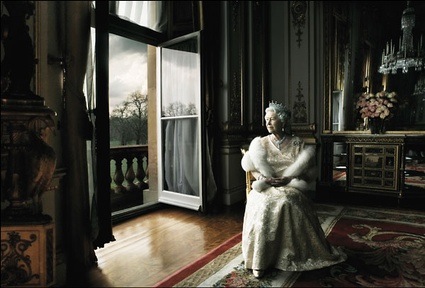 Annie Leibovitz, Queen Elizabeth II. Courtesy Contact Press/NB Pictures
Annie Leibovitz, Queen Elizabeth II. Courtesy Contact Press/NB Pictures
The current UK constitution might not have left Queen Elizabeth II of England as much authority as her ancestors enjoyed. Her aura, status and personality however have granted her an unique power over public imagination. American photographer Annie Leibovitz was commissioned a series of portrait of the sovereign in occasion of her travel to the United States.
The series is almost as famous for the images as it is for an episode in which Queen Elizabeth II would have allegedly ‘lost her cool’ and stormed out of a photo shoot after Leibovitz had suggested she’d remove her crown for a portrait.
However, it soon emerged that a BBC video was responsible for the scandal in the British press. BBC had indeed edited a series of sequences about the photo shoot to suggest that the Queen had found the photographer’s request outrageous. In reality, the Queen had remained calm and composed all along. The broadcaster immediately apologized for the unfortunate video editing.
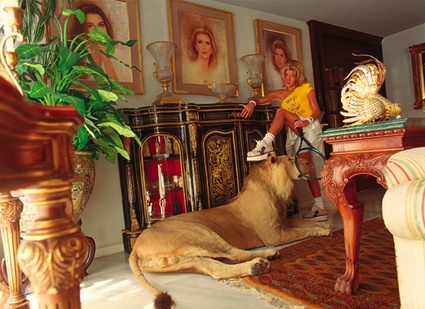 Daniela Rossell, Paulina with Lion, Untitled (Ricas y Famosas)
Daniela Rossell, Paulina with Lion, Untitled (Ricas y Famosas)
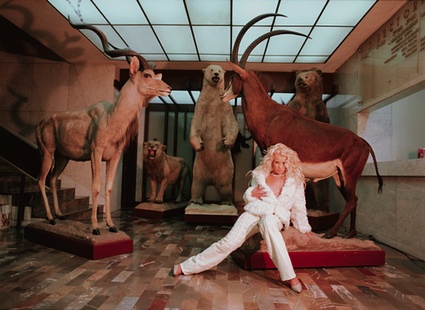 Daniela Rossell, Janita in Her Father’s Office, Untitled (Ricas y Famosas)
Daniela Rossell, Janita in Her Father’s Office, Untitled (Ricas y Famosas)
A chapter of the exhibition is dedicated to the representation or self-representation of members of the ‘high society.’ As their title indicates, Daniela Rossell‘s Ricas y Famosas series portrays young women from the Mexican upper classes flaunting their prosperity (or rather their father’s or husband’s) and garish taste.
The Ricas y Famosas are a minority in their country. Rossell is actually one of them. That’s probably why the young women felt comfortable with her and agreed to be photographed in the setting of their own choice. However, after the photos attracted critical press, many of them requested to pull out of the project.
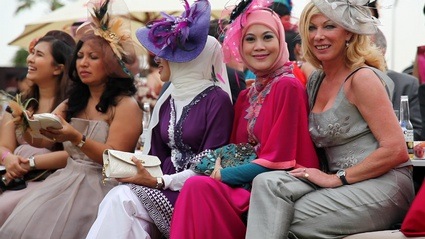
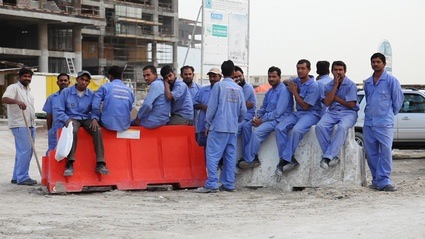
The most moving work for me was Francesco Jodice‘s viceo DUBAI_CITYTELLERS, part of a trilogy exploring how certain areas in the world have become complex symbols of power. Jodice’s portrayal of Dubai alternates scenes we know too well (spectacular buildings by starchitects, camel races, snow park, ladies in jewels but also shots of the appalling quarters where migrant workers are condemned to sleep) with short and compelling interviews with Western and Eastern immigrants, as well as local politicians and journalists.
Contrasting views expressed in the movie shape a land where overkill dreams are possible but where immigrants, who are employed as cheap labour in the building sector and as servants in the house of wealthy Dubaites, live in dreadful conditions. It’s also on the exploitation of their work and of social inequalities that the economic growth of the country is made possible.
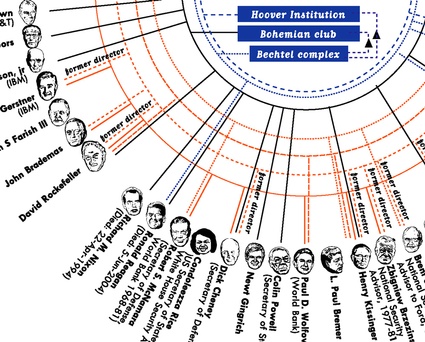 Bureau d’études, Detail of Bohemian Club, 2005
Bureau d’études, Detail of Bohemian Club, 2005
The critical investigation of the curators doesn’t stop at the portraits of the rich, the famous and the powerful whose faces are regularly gracing newspapers and magazines. A section of the show is dedicated to hidden authority structures such as multinational corporations, business banks, the CIA and supranational inspection bodies.
Paradoxically, that’s also where we meet the artists this blog is more familiar with: Bureau d’études, Trevor Paglen and The Yes Men. In consequence, and even if i admire their work immensely, i’ll just brush on their contribution to the show.
On 3 December 2004, Andy Bichlbaum of The Yes Men appeared on BBC news in the role of Jude Finisterra, a fictional spokesmen for Dow Chemical – the multinational corporation that owns Union Carbide, the company responsible for the chemical disaster that took place in the area around the city of Bhopal in India. He was announcing to the world that 20 years after the Bhopal tragedy Dow was finally accepting full responsibility for the world’s worst industrial catastrophe and offering compensation to all the victims of the disaster, for a total of around twelve billion dollars.
While the company immediately denied these statements, in the twenty minutes that followed the interview Dow’s stocks lost 4% of their value. The action, which mimicked the media strategies adopted by multinationals, also helped to bring the Bhopal disaster back to the attention of the public.
Their action proved more effective than other protest strategies, as modern corporations, institutions and political bodies base their own credibility, and hence power, on the well-planned construction of a positive public image. In the contemporary society of images, attacks against the power of an economic or political authority will prove more effective if they are directed against its façade as opposed to its internal mechanisms.
I’ve been a regular visitor of the Florence cultural center since early 2008. This exhibition, just like the ones i saw before, did not disappoint with its selection of artworks from both emerging artists and auction house favourites, solid investigation into a timely topic, and availability of the catalogue essays online.
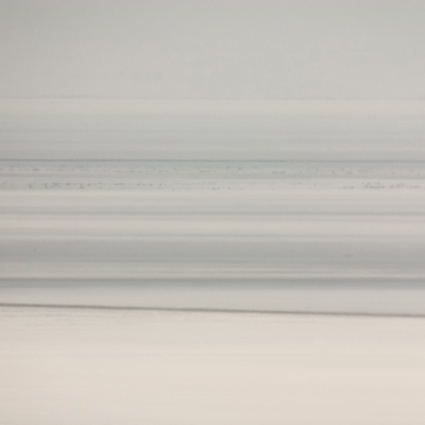 © Trevor Paglen, Chemical and Biological Weapons Proving Ground / Dugway, UT; Distance ~ 42 miles; 10:51 a.m., 2006
© Trevor Paglen, Chemical and Biological Weapons Proving Ground / Dugway, UT; Distance ~ 42 miles; 10:51 a.m., 2006
Portraits and Power is a project of the CCC Strozzina, with the consultancy of Peter Funnell (National Portrait Gallery, London), Walter Guadagnini (“UniCredit & Art” project) and Roberta Valtorta (Museum of Contemporary Photography, Cinisello Balsamo) coordinated by Franziska Nori (CCCS, Firenze).
Portraits and Power is on view at CCC Strozzina in Florence through 23 January 2011.
Image on the homepage: Martin Parr, “France. Paris. Haute Couture”, 2007, Luxury. © Martin Parr / Magnum Photos.


